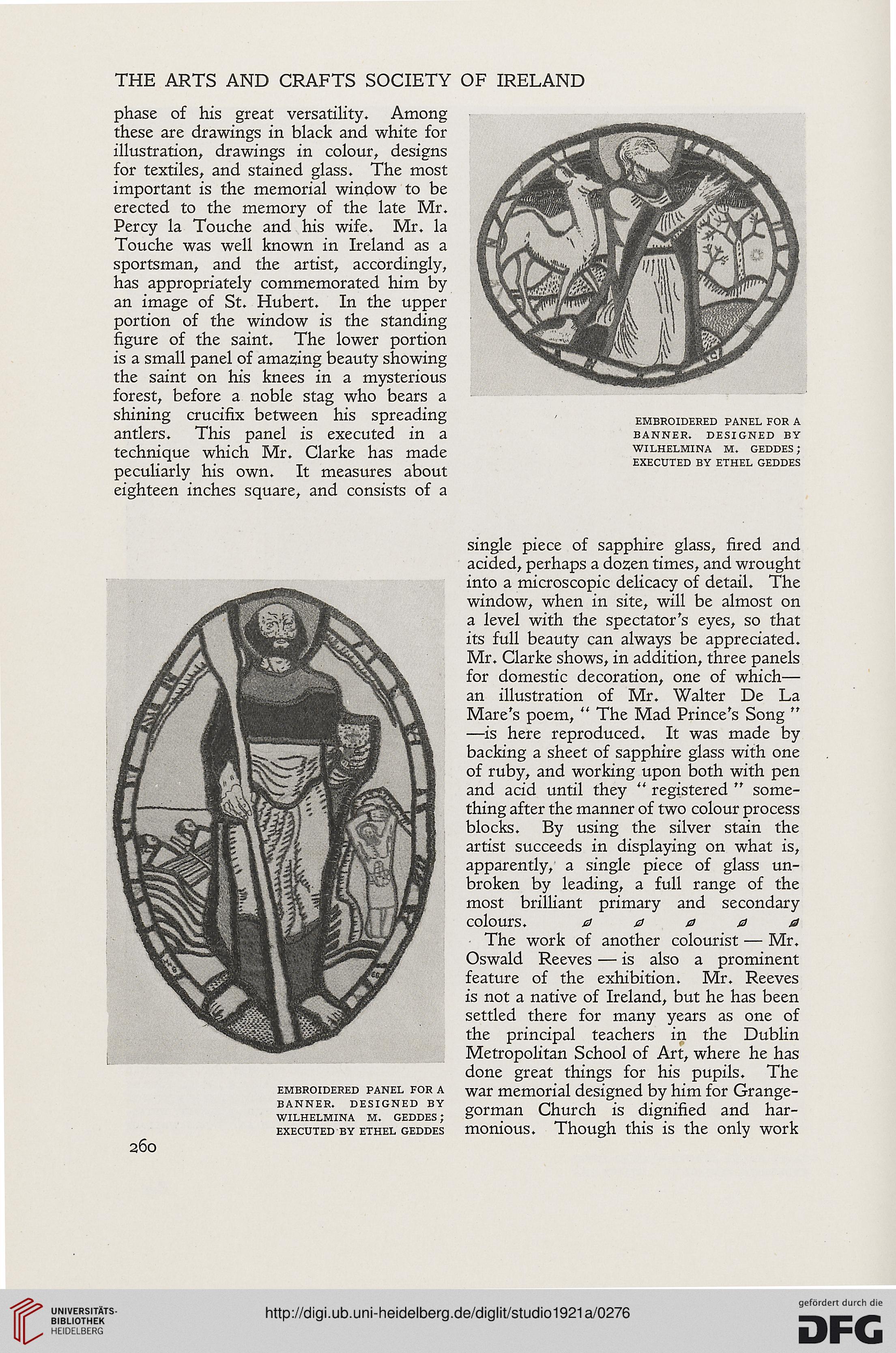THE ARTS AND CRAFTS SOCIETY OF IRELAND
phase of his great versatility. Among
these are drawings in black and white for
illustration, drawings in colour, designs
for textiles, and stained glass. The most
important is the memorial window to be
erected to the memory of the late Mr.
Percy la Touche and his wife. Mr. la
Touche was well known in Ireland as a
sportsman, and the artist, accordingly,
has appropriately commemorated him by
an image of St. Hubert. In the upper
portion of the window is the standing
figure of the saint. The lower portion
is a small panel of amazing beauty showing
the saint on his knees in a mysterious
forest, before a noble stag who bears a
shining crucifix between his spreading
antlers. This panel is executed in a
technique which Mr. Clarke has made
peculiarly his own. It measures about
eighteen inches square, and consists of a
EMBROIDERED PANEL FOR A
BANNER. DESIGNED BY
WILHELMINA M. GEDDES;
EXECUTED BY ETHEL GEDDES
260
EMBROIDERED PANEL FOR A
BANNER. DESIGNED BY
WILHELMINA M. GEDDES ;
EXECUTED BY ETHEL GEDDES
single piece of sapphire glass, fired and
acided, perhaps a dozen times, and wrought
into a microscopic delicacy of detail. The
window, when in site, will be almost on
a level with the spectator's eyes, so that
its full beauty can always be appreciated.
Mr. Clarke shows, in addition, three panels
for domestic decoration, one of which—
an illustration of Mr. Walter De La
Mare's poem, " The Mad Prince's Song "
—is here reproduced. It was made by
backing a sheet of sapphire glass with one
of ruby, and working upon both with pen
and acid until they " registered " some-
thing after the manner of two colour process
blocks. By using the silver stain the
artist succeeds in displaying on what is,
apparently/ a single piece of glass un-
broken by leading, a full range of the
most brilliant primary and secondary
colours. a a a 0 a
■ The work of another colourist ■— Mr.
Oswald Reeves — is also a prominent
feature of the exhibition. Mr. Reeves
is not a native of Ireland, but he has been
settled there for many years as one of
the principal teachers in the Dublin
Metropolitan School of Art, where he has
done great things for his pupils. The
war memorial designed by him for Grange-
gorman Church is dignified and har-
monious. Though this is the only work
phase of his great versatility. Among
these are drawings in black and white for
illustration, drawings in colour, designs
for textiles, and stained glass. The most
important is the memorial window to be
erected to the memory of the late Mr.
Percy la Touche and his wife. Mr. la
Touche was well known in Ireland as a
sportsman, and the artist, accordingly,
has appropriately commemorated him by
an image of St. Hubert. In the upper
portion of the window is the standing
figure of the saint. The lower portion
is a small panel of amazing beauty showing
the saint on his knees in a mysterious
forest, before a noble stag who bears a
shining crucifix between his spreading
antlers. This panel is executed in a
technique which Mr. Clarke has made
peculiarly his own. It measures about
eighteen inches square, and consists of a
EMBROIDERED PANEL FOR A
BANNER. DESIGNED BY
WILHELMINA M. GEDDES;
EXECUTED BY ETHEL GEDDES
260
EMBROIDERED PANEL FOR A
BANNER. DESIGNED BY
WILHELMINA M. GEDDES ;
EXECUTED BY ETHEL GEDDES
single piece of sapphire glass, fired and
acided, perhaps a dozen times, and wrought
into a microscopic delicacy of detail. The
window, when in site, will be almost on
a level with the spectator's eyes, so that
its full beauty can always be appreciated.
Mr. Clarke shows, in addition, three panels
for domestic decoration, one of which—
an illustration of Mr. Walter De La
Mare's poem, " The Mad Prince's Song "
—is here reproduced. It was made by
backing a sheet of sapphire glass with one
of ruby, and working upon both with pen
and acid until they " registered " some-
thing after the manner of two colour process
blocks. By using the silver stain the
artist succeeds in displaying on what is,
apparently/ a single piece of glass un-
broken by leading, a full range of the
most brilliant primary and secondary
colours. a a a 0 a
■ The work of another colourist ■— Mr.
Oswald Reeves — is also a prominent
feature of the exhibition. Mr. Reeves
is not a native of Ireland, but he has been
settled there for many years as one of
the principal teachers in the Dublin
Metropolitan School of Art, where he has
done great things for his pupils. The
war memorial designed by him for Grange-
gorman Church is dignified and har-
monious. Though this is the only work




